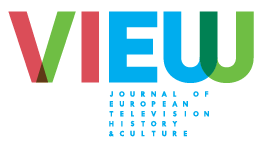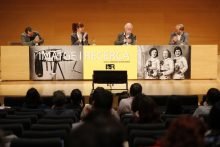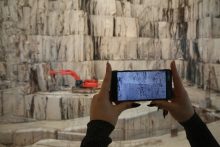 Considering the relevance of audiovisual material as perhaps the biggest wave of data to come in the near future (Smith, 2013, IBM prospective study) its relatively modest position within the realm of Digital Humanities conferences is remarkable. The objective of this special issue for VIEW is to present current research in that field on a variety of epistemological, historiographical and technological issues that are specific for digital methods applied to audiovisual data. We strive to cover a great range of media and data types and of applications representing the various stages of the research process.
Considering the relevance of audiovisual material as perhaps the biggest wave of data to come in the near future (Smith, 2013, IBM prospective study) its relatively modest position within the realm of Digital Humanities conferences is remarkable. The objective of this special issue for VIEW is to present current research in that field on a variety of epistemological, historiographical and technological issues that are specific for digital methods applied to audiovisual data. We strive to cover a great range of media and data types and of applications representing the various stages of the research process.
The following key topics / problems / questions are of special interest:
- Do computational approaches to sound and (moving) images extend or/and change our conceptual and epistemological understanding of these media? What are the leading machine learning approaches to the study of audio and visual culture and particularly time-based media? How do these approaches, models, and methods of learning relate to acquiring and producing knowledge by the conventional means of reading and analyzing text? Do we understand the 20th century differently through listening to sounds and voices and viewing images than through reading texts? How does massive digitization and online access relate to the concept of authenticity and provenance?
- What tools in the sequence of the research process – search, annotation, vocabulary, analysis, presentation – are best suited to work with audio-visual data? The ways in which we structure and process information are primarily determined by the convention of attributing meaning to visual content through text. Does searching audio-visual archives, annotating photos or film clips, analyzing a corpus of city sounds, or presenting research output through a virtual exhibition, require special dedicated tools? What is the diversity in requirements within the communities of humanities scholars? How can, for example, existing commercial tools or software be repurposed for scholarly use?
- What are the main hurdles for the further expansion of AV in DH? Compared to text, audiovisual data as carriers of knowledge are a relatively young phenomenon. Consequently the question of ‘ownership’ and the commercial value of many audiovisual sources result in considerable constraints for use due to issues of copyright. A constraint of a completely different order, is the intensive investment in time needed when listening to or watching an audiovisual corpus, compared to reading a text. Does the law or do technologies for speech and image retrieval offer solutions to overcome these obstacles?
Practicals:
Contributions are encouraged from authors with different kinds of expertise and interests in media studies, digital humanities, television and media history.
Paper proposals (max. 500 words) are due on October 2nd, 2017.
Submissions should be sent to the managing editor of the journal, Dana Mustata.
A notice of acceptance will be sent to authors in the 1st week of November 2017.
Articles (3 – 6,000 words) will be due on 15th of February 2018. Longer articles are welcome, given that they comply with the journal’s author guidelines.
For further information or questions about the issue, please contact the co-editors: Mark Williams (Associate Professor Film and Media Studies, Dartmouth College U.S.), Pelle Snickars (Prof. of Media Studies Umea Univesity, Sweden) or Andreas Fickers (Luxembourg Centre for Contemporary and Digital History).
About VIEW Journal
See http://www.viewjournal.eu/ for the current and back issues. VIEW is supported by the EUscreen Network and published by the Netherlands Institute for Sound and Vision in collaboration with Utrecht University, Royal Holloway University of London, and University of Luxembourg. VIEW is proud to be an open access journal. All articles are indexed through the Directory of Open Access Journals, the EBSCO Film and Television Index, Paperity and NARCIS.






 If you have interesting news and events to point out in the field of digital cultural heritage, we are waiting for your contribution.
If you have interesting news and events to point out in the field of digital cultural heritage, we are waiting for your contribution.
























